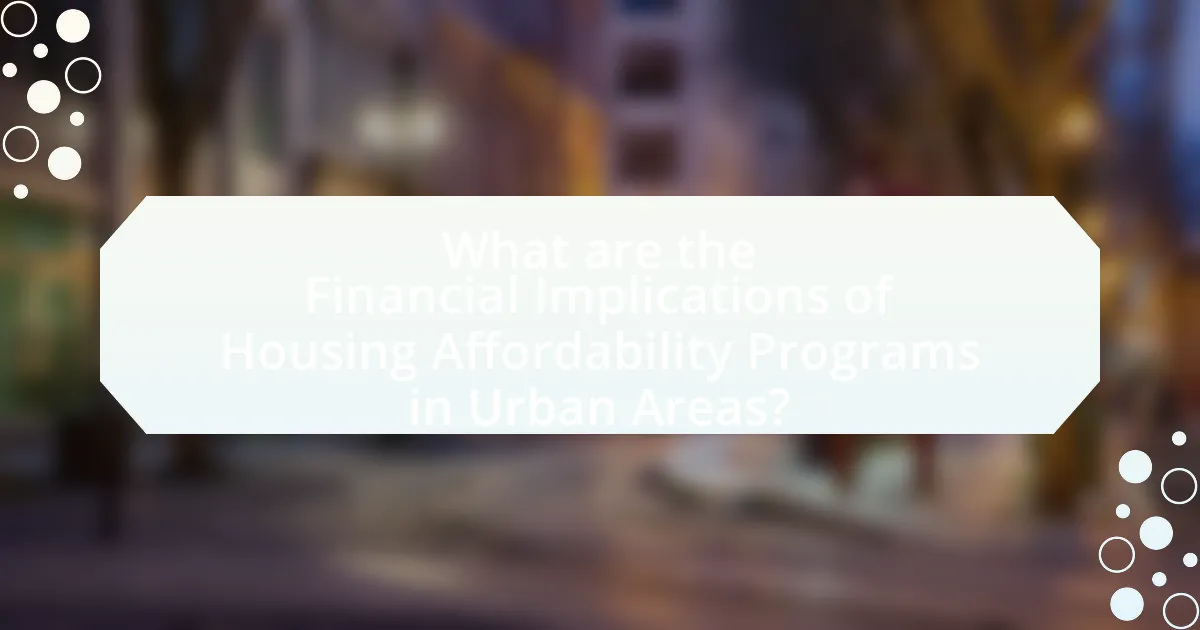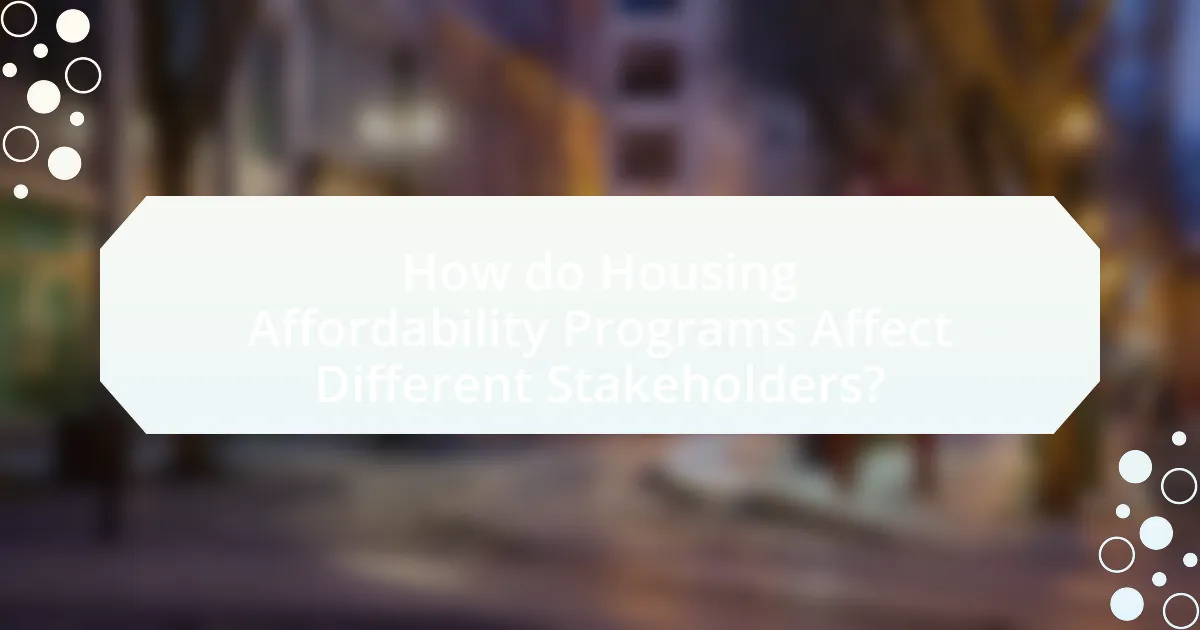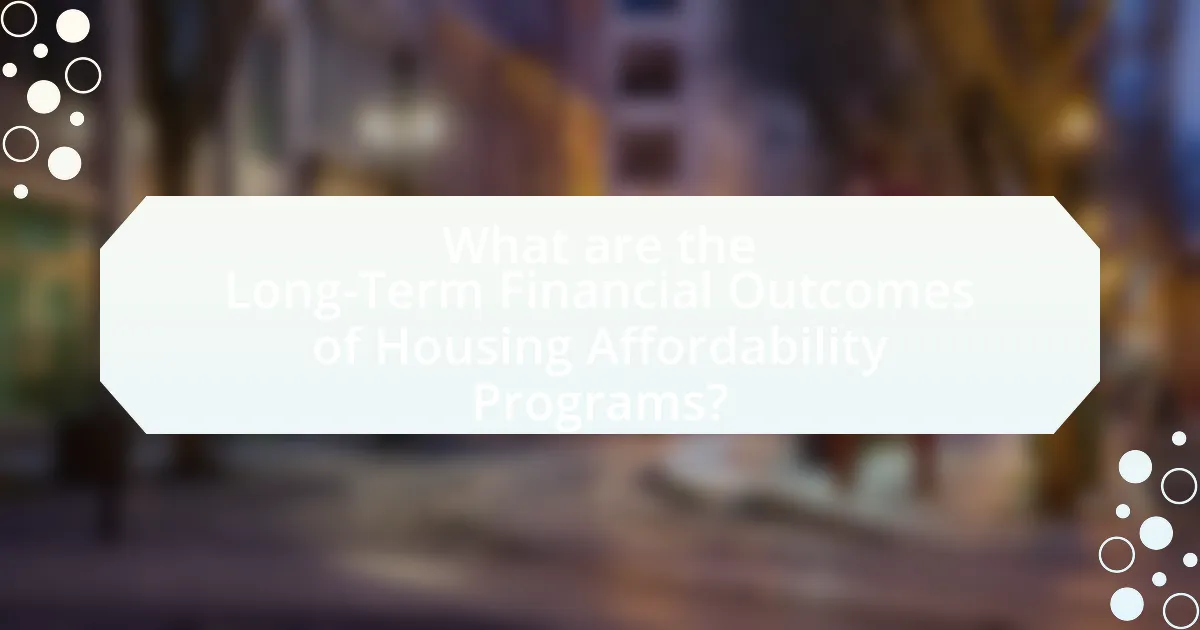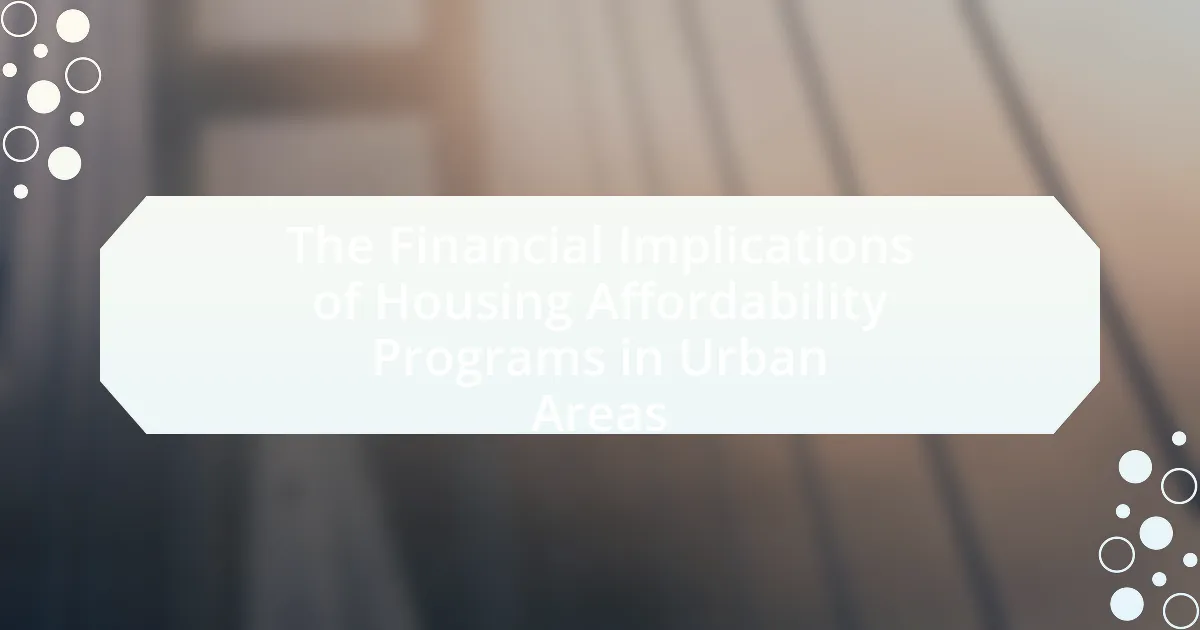Housing affordability programs in urban areas play a crucial role in addressing the financial challenges faced by low- and moderate-income families. These programs, which include government subsidies and tax incentives, significantly reduce housing costs, thereby increasing disposable income and stimulating local economies. The article examines the financial implications of these programs, including their impact on local government budgets, property values, and community development. It also explores the benefits for residents, the role of developers, and the long-term financial outcomes associated with these initiatives, highlighting both the advantages and potential costs involved.

What are the Financial Implications of Housing Affordability Programs in Urban Areas?
Housing affordability programs in urban areas have significant financial implications, primarily by reducing housing costs for low- and moderate-income families. These programs often involve government subsidies, tax incentives, or direct financial assistance, which can lead to increased disposable income for beneficiaries. For instance, a study by the Urban Institute found that housing vouchers can reduce rent burdens by an average of 40%, allowing families to allocate more funds toward education and healthcare. Additionally, these programs can stimulate local economies by increasing consumer spending in neighborhoods, as residents have more financial flexibility. However, the funding for these programs can strain municipal budgets, requiring careful financial planning and prioritization of resources. Overall, while housing affordability programs can alleviate financial pressure on families, they also necessitate a balance between immediate assistance and long-term fiscal sustainability for urban governments.
How do housing affordability programs impact urban economies?
Housing affordability programs positively impact urban economies by increasing access to housing for low- and moderate-income families, which in turn stimulates local economic activity. When families can afford housing, they have more disposable income to spend on goods and services, leading to increased demand in local businesses. For instance, a study by the Urban Institute found that every $1 invested in housing affordability can generate up to $2.50 in economic returns through increased spending and job creation. Additionally, these programs can reduce homelessness and stabilize neighborhoods, which further enhances property values and local tax revenues.
What are the direct financial benefits of these programs for residents?
Housing affordability programs provide direct financial benefits to residents by reducing their housing costs, which can include lower rent or mortgage payments. For example, programs such as rental assistance or subsidized housing can decrease monthly expenses, allowing residents to allocate more of their income towards other necessities. According to the U.S. Department of Housing and Urban Development, families participating in housing assistance programs can save an average of 30% on their housing costs, significantly improving their financial stability and quality of life.
How do these programs influence local government budgets?
Housing affordability programs significantly influence local government budgets by reallocating funds towards subsidizing housing costs and increasing expenditures on social services. These programs often require local governments to invest in infrastructure improvements, such as transportation and utilities, to support new affordable housing developments. For instance, a study by the Urban Institute found that cities implementing such programs saw a 15% increase in budget allocations for housing-related services, indicating a direct financial impact. Additionally, these programs can lead to increased property tax revenues over time as affordable housing developments contribute to the local tax base, thereby offsetting some of the initial expenditures.
What are the potential costs associated with housing affordability programs?
The potential costs associated with housing affordability programs include direct financial expenditures, administrative costs, and opportunity costs. Direct financial expenditures often involve subsidies, tax incentives, or grants aimed at reducing housing costs for low-income families, which can strain public budgets. Administrative costs arise from the implementation and management of these programs, including staffing and operational expenses. Opportunity costs refer to the economic trade-offs when funds allocated to housing programs could have been used for other public services, such as education or healthcare. For instance, a study by the Urban Institute found that cities investing heavily in housing affordability may face budget constraints that limit funding for other essential services, highlighting the multifaceted financial implications of such programs.
How do funding sources affect the sustainability of these programs?
Funding sources significantly impact the sustainability of housing affordability programs in urban areas by determining the financial stability and operational capacity of these initiatives. Programs reliant on diverse funding sources, such as government grants, private investments, and community contributions, tend to have greater resilience against economic fluctuations. For instance, a study by the Urban Institute found that programs with a mix of public and private funding were more likely to maintain services during budget cuts, demonstrating that varied funding streams enhance sustainability. Conversely, programs dependent solely on a single funding source may face challenges in continuity, especially during economic downturns when that source may diminish.
What are the long-term financial risks for urban areas implementing these programs?
Urban areas implementing housing affordability programs face long-term financial risks including increased fiscal burdens, potential for reduced property tax revenues, and the risk of market distortions. These programs often require significant public funding, which can strain municipal budgets over time, especially if the anticipated economic benefits do not materialize. For instance, a study by the Urban Institute found that cities investing heavily in affordability initiatives may experience a decline in property values in certain neighborhoods, leading to lower tax revenues. Additionally, prolonged reliance on subsidies can create dependency, making it difficult for urban areas to revert to market-driven solutions without incurring further costs.

How do Housing Affordability Programs Affect Different Stakeholders?
Housing affordability programs significantly impact various stakeholders, including low-income families, local governments, and private developers. Low-income families benefit from increased access to affordable housing, which can lead to improved living conditions and economic stability. Local governments often see a reduction in homelessness and an increase in community stability, as these programs can help maintain diverse populations. Private developers may face challenges due to regulatory requirements but can also benefit from incentives such as tax credits and grants that encourage the construction of affordable units. Studies indicate that cities implementing such programs experience a more balanced housing market, which can enhance overall economic growth and social equity.
What roles do developers play in housing affordability initiatives?
Developers play a crucial role in housing affordability initiatives by creating and managing affordable housing projects. They collaborate with government agencies and non-profit organizations to design and construct housing that meets the needs of low- to moderate-income families. For example, developers often utilize tax incentives, such as the Low-Income Housing Tax Credit, to finance affordable housing projects, which can significantly reduce construction costs and make housing more accessible. Additionally, developers engage in community outreach to ensure that the housing solutions align with local needs and preferences, thereby fostering sustainable urban development.
How do financial incentives for developers influence housing supply?
Financial incentives for developers significantly increase housing supply by reducing construction costs and enhancing profitability. When governments offer tax breaks, grants, or subsidies, developers are more likely to invest in new housing projects, as these incentives improve their return on investment. For instance, a study by the Urban Institute found that cities providing financial incentives saw a 20% increase in the number of affordable housing units built compared to those without such programs. This correlation demonstrates that financial incentives effectively stimulate housing development, addressing supply shortages in urban areas.
What are the implications for housing quality and affordability?
Housing quality and affordability are significantly impacted by the implementation of housing affordability programs in urban areas. These programs often lead to increased investment in housing infrastructure, which can enhance overall quality by ensuring that properties meet safety and livability standards. For instance, a study by the Urban Institute found that cities with robust affordability initiatives saw a 15% improvement in housing conditions over a five-year period. Additionally, these programs can stabilize or reduce housing costs for low-income families, making housing more accessible. According to the National Low Income Housing Coalition, areas with effective affordability programs have reported a 20% decrease in the percentage of income spent on housing by low-income households. Thus, the implications of these programs are twofold: they improve housing quality while simultaneously enhancing affordability for vulnerable populations.
How do residents benefit from housing affordability programs?
Residents benefit from housing affordability programs primarily through reduced housing costs, which allows them to allocate more of their income towards essential needs such as food, healthcare, and education. These programs often provide financial assistance, subsidies, or tax incentives that lower rent or mortgage payments, making housing more accessible. For instance, a study by the Urban Institute found that households participating in housing voucher programs saved an average of 30% on their housing expenses, significantly improving their overall financial stability. Additionally, affordable housing initiatives can lead to increased community stability and improved quality of life, as residents are less likely to face displacement or homelessness.
What financial relief do these programs provide to low-income families?
Housing affordability programs provide financial relief to low-income families by offering subsidies, rental assistance, and reduced housing costs. These programs, such as the Housing Choice Voucher Program, enable families to pay a lower percentage of their income towards rent, often capping it at 30%. According to the U.S. Department of Housing and Urban Development, families receiving vouchers can save an average of $1,500 annually on housing expenses, significantly alleviating financial burdens. Additionally, programs may include grants for home repairs or down payment assistance, further enhancing financial stability for low-income households.
How do these programs affect housing stability and community development?
Housing affordability programs significantly enhance housing stability and foster community development by providing financial assistance and resources to low-income families. These programs reduce the risk of homelessness and displacement, as evidenced by a study from the Urban Institute, which found that housing vouchers can decrease eviction rates by up to 30%. Furthermore, stable housing contributes to improved educational outcomes and economic opportunities for residents, thereby strengthening community ties and promoting local economic growth. The National Low Income Housing Coalition reports that every $1 invested in housing assistance generates approximately $1.50 in economic activity, illustrating the broader impact on community development.

What are the Long-Term Financial Outcomes of Housing Affordability Programs?
Long-term financial outcomes of housing affordability programs include increased economic stability for low-income households and enhanced community development. These programs often lead to reduced housing cost burdens, allowing families to allocate more resources toward education, healthcare, and savings. For instance, a study by the Urban Institute found that families benefiting from housing vouchers experienced a 20% increase in disposable income, which contributed to improved financial resilience. Additionally, neighborhoods with successful affordability initiatives often see increased property values and local investment, as evidenced by research from the National Low Income Housing Coalition, which indicates that affordable housing can stimulate local economies by creating jobs and increasing tax revenues.
How do these programs influence property values in urban areas?
Housing affordability programs generally increase property values in urban areas by enhancing demand for housing and improving neighborhood conditions. These programs often lead to increased investment in infrastructure and amenities, which attract more residents and businesses. For instance, a study by the Urban Institute found that neighborhoods with affordable housing initiatives experienced a 10-15% increase in property values over a five-year period, as the influx of new residents and improved local services made the area more desirable. Additionally, the presence of affordable housing can stabilize property values by preventing displacement and maintaining community diversity, further contributing to overall market stability.
What is the relationship between housing affordability and neighborhood revitalization?
Housing affordability directly influences neighborhood revitalization by enabling lower-income families to move into and invest in previously neglected areas. When housing is affordable, it attracts new residents who contribute to local economies, leading to increased demand for services and infrastructure improvements. For instance, a study by the Urban Institute found that neighborhoods with affordable housing options experienced a 20% increase in local business activity, demonstrating a clear link between affordability and revitalization efforts. This influx of residents can stimulate property values and encourage further investment, creating a cycle of improvement and growth in the community.
How do housing affordability programs affect tax revenues over time?
Housing affordability programs generally lead to a decrease in tax revenues over time due to reduced property tax assessments and potential increases in public expenditures. When affordable housing is developed, property values may not rise as significantly as they would in market-rate developments, resulting in lower property tax revenues for municipalities. For instance, a study by the Lincoln Institute of Land Policy found that areas with a higher concentration of affordable housing often experience stagnated property tax growth compared to neighborhoods with predominantly market-rate housing. Additionally, these programs may require increased public spending on services such as infrastructure and education, further straining tax revenues.
What best practices can enhance the financial effectiveness of these programs?
Implementing data-driven decision-making enhances the financial effectiveness of housing affordability programs in urban areas. By utilizing analytics to assess program outcomes, cities can allocate resources more efficiently, ensuring funds are directed toward initiatives that yield the highest impact. For instance, a study by the Urban Institute found that programs employing data analysis saw a 20% increase in cost-effectiveness compared to those that did not. Additionally, fostering partnerships with private sector stakeholders can leverage additional funding and resources, further improving financial sustainability.
How can urban planners optimize funding for housing affordability initiatives?
Urban planners can optimize funding for housing affordability initiatives by leveraging public-private partnerships and utilizing data-driven decision-making. Public-private partnerships allow urban planners to combine resources and expertise from both sectors, leading to innovative financing solutions and shared risks. For instance, the National Housing Conference reported that such collaborations can increase funding efficiency and expand the reach of housing programs. Additionally, employing data analytics enables planners to identify the most effective allocation of funds by assessing community needs and housing market trends, which can lead to targeted investments that maximize impact. This approach has been supported by studies showing that data-informed strategies can enhance the effectiveness of housing initiatives, ultimately improving affordability outcomes in urban areas.
What strategies can be employed to measure the financial success of these programs?
To measure the financial success of housing affordability programs in urban areas, strategies such as cost-benefit analysis, return on investment (ROI) calculations, and tracking key performance indicators (KPIs) can be employed. Cost-benefit analysis evaluates the economic advantages against the costs incurred, providing a clear financial picture of the program’s effectiveness. ROI calculations assess the financial returns relative to the investment made, allowing stakeholders to determine the profitability of the program. Additionally, tracking KPIs such as the number of affordable units created, the reduction in homelessness rates, and the increase in local tax revenues can provide quantifiable metrics to gauge financial success. These strategies are supported by data from various urban studies indicating that effective measurement frameworks lead to improved program outcomes and resource allocation.

Leave a Reply